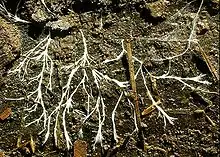
Saprotrophic nutrition /sæprəˈtrɒfɪk, -proʊ-/[1] or lysotrophic nutrition[2] is a process of chemoheterotrophic extracellular digestion involved in the processing of decayed (dead or waste) organic matter. It occurs in saprotrophs, and is most often associated with fungi (for example Mucor) and soil bacteria. Saprotrophic microscopic fungi are sometimes called saprobes. Saprotrophic plants or bacterial flora are called saprophytes (sapro- 'rotten material' + -phyte 'plant'), although it is now believed that all plants previously thought to be saprotrophic are in fact parasites of microscopic fungi or other plants. The process is most often facilitated through the active transport of such materials through endocytosis within the internal mycelium and its constituent hyphae.[3]
Various word roots relating to decayed matter (detritus, sapro-), eating and nutrition (-vore, -phage), and plants or life forms (-phyte, -obe) produce various terms, such as detritivore, detritophage, saprotroph, saprophyte, saprophage, and saprobe; their meanings overlap, although technical distinctions (based on physiologic mechanisms) narrow the senses. For example, usage distinctions can be made based on macroscopic swallowing of detritus (as an earthworm does) versus microscopic lysis of detritus (as a mushroom does).
Process
As matter decomposes within a medium in which a saprotroph is residing, the saprotroph breaks such matter down into its composites.
- Proteins are broken down into their amino acid composites through the breaking of peptide bonds by proteases.[4]
- Lipids are broken down into fatty acids and glycerol by lipases.[4]
- Starch is broken down into pieces of simple disaccharides by amylases.[4]
- Cellulose, a major portion of plant cells, and therefore a major constituent of decaying matter is broken down into glucose
These products are re-absorbed into the hypha through the cell wall by endocytosis and passed on throughout the mycelium complex. This facilitates the passage of such materials throughout the organism and allows for growth and, if necessary, repair.[3]
Conditions
In order for a saprotrophic organism to facilitate optimal growth and repair, favourable conditions and nutrients must be present.[5] Optimal conditions refers to several conditions which optimise the growth of saprotrophic organisms, such as;
- Presence of water: 80–90% of the mass of the fungi is water, and the fungi require excess water for absorption due to the evaporation of internally retained water.[5]
- Presence of oxygen: Very few saprotrophic organisms can endure anaerobic conditions as evidenced by their growth above media such as water or soil.[5]
- Neutral-acidic pH: The condition of neutral or mildly acidic conditions under pH 7 are required. [5]
- Low-medium temperature: The majority of saprotrophic organisms require temperatures between 1 °C and 35 °C (33.8 °F and 95 °F), with optimum growth occurring at 25 °C (77 °F).[5]
The majority of nutrients taken in by such organisms must be able to provide carbon, proteins, vitamins and, in some cases, ions. Due to the carbon composition of the majority of organisms, dead and organic matter provide rich sources of disaccharides and polysaccharides such as maltose and starch, and of the monosaccharide glucose.[3]
In terms of nitrogen-rich sources, saprotrophs require combined protein for the creation of proteins, which is facilitated by the absorption of amino acids, and usually taken from rich soil. Although both ions and vitamins are rare, thiamine or ions such as potassium, phosphorus, and magnesium aid the growth of the mycelium.[3]
See also
References
- ↑ "saprotroph - definition of saprotroph in English from the Oxford dictionary". OxfordDictionaries.com. Archived from the original on November 8, 2012. Retrieved 2016-01-20.
- ↑ "The Ecology of Story: Revealing Hidden Characters of the Forest". April 25, 2020.
- 1 2 3 4 Clegg & Mackean (2006, p. 296) states the purpose of saprotrophs and their internal nutrition, as well as the main two types of fungi that are most often referred to, as well as describes, visually, the process of saprotrophic nutrition through a diagram of hyphae, referring to the Rhizobium on damp, stale whole-meal bread or rotting fruit.
- 1 2 3 Clegg & Mackean (2006, p. 296), fig 14.16—Diagram detailing the re-absorption of substrates within the hypha.
- 1 2 3 4 5 Clegg & Mackean (2006, p. 296), fig 14.17—A diagram explaining the optimal conditions needed for successful growth and repair.
Further reading
- Clegg, C. J.; Mackean, D. G. (2006). Advanced Biology: Principles and Applications (2nd ed.). Hodder Publishing.
- Zmitrovich, I. V.; Wasser, S. P.; Ţura, D. (2014). "Wood-inhabiting fungi" (PDF). In Misra, J. K.; Tewari, J. P.; Deshmukh, S. K.; Vágvölgyi, C. (eds.). Fungi from Different Substrates. N. Y.: CRC Press, Taylor and Francis group. pp. 17–74.